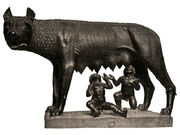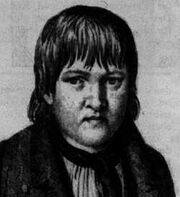Assessment |
Biopsychology |
Comparative |
Cognitive |
Developmental |
Language |
Individual differences |
Personality |
Philosophy |
Social |
Methods |
Statistics |
Clinical |
Educational |
Industrial |
Professional items |
World psychology |
Developmental Psychology: Cognitive development · Development of the self · Emotional development · Language development · Moral development · Perceptual development · Personality development · Psychosocial development · Social development · Developmental measures
A feral child (feral, i.e., "wild" or undomesticated) is a human child who, from a very young age, has lived in isolation from human contact and has remained unaware of human social behavior, and unexposed to language. Feral children are extremely rare. Throughout the world, just over a hundred incidences of the phenomenon have been reported.[1] They are thus considered very interesting case studies from a sociological perspective.
Origins and effects[]
Feral children may be separated from society by being lost or abandoned in the wild. The category also includes children who have been purposely kept apart from human society, e.g. kept in a room in solitary confinement. Sometimes abandonment is because of parents rejecting a child's severe intellectual impairment or physical disability, and some feral children experience severe child abuse or trauma before being abandoned.
Some myths and legends, and later many fictional stories depict feral children as having been reared by wild animals such as wolves or bears. Famous examples include Edgar Rice Burroughs's Tarzan and Rudyard Kipling's Mowgli, as well as the legend of Romulus and Remus.
Legendary and fictional feral children are often depicted as growing up with relatively normal human intelligence and skills and an innate sense of culture or civilization, coupled with a healthy dose of survival instincts; their integration into human society is made to seem relatively easy. In reality, however, feral children lack the basic social skills which are normally learned in the process of enculturation. For example, they may be unable to learn to use a toilet, have trouble learning to walk upright and display a complete lack of interest in the human activity around them. They often seem mentally impaired and have almost insurmountable trouble learning a human language. The subject is treated with a certain amount of realism in François Truffaut's 1970 film L'Enfant Sauvage (UK: The Wild Boy, US: The Wild Child), where a scientist's efforts in trying to rehabilitate a feral boy meet with great difficulty.
It is essentially impossible to convert a child who became isolated at a very young age into a relatively normal member of society. Such individuals need close care throughout their lives, if they are to live in human society. As they are "discovered", feral children also tend to become the subject of lively scientific and media interest. Once the excitement dies down and their limitations in terms of learning culture and social behaviour become obvious, frustration can set in and they often spend the rest of their lives being passed from one caregiver to another. It is common for them to die young, though obviously, their potential lifespan if they had been left in the wild is difficult to know.
Ancient reports[]
Herodotus, the historian, wrote that Egyptian pharaoh Psammetichus I (Psamtik) sought to discover the origin of language by conducting an experiment with two children. Allegedly, he gave two newborn babies to a shepherd, with the instructions that no one should speak to them, but that the shepherd should feed and care for them while listening to determine their first words. The hypothesis was that the first word would be uttered in the root language of all people. When one of the children cried “becos” (a sound quite similar to the bleating of sheep) with outstretched arms the shepherd concluded that the word was Phrygian because that was the sound of Phrygian word for “bread.” Thus, they concluded that the Phrygians were an older people than the Egyptians. The veracity of this story is, of course, impossible to determine.

The Capitoline Wolf suckling Romulus and Remus
Real-life cases[]

Kaspar Hauser
Of the approximately 100 cases often cited, few have been confirmed or well studied, many lack detail, and many may have been exaggerated and embellished. Here is a limited list:
- Hessian wolf-children (1341-1344).[How to reference and link to summary or text]
- The Bamberg boy, who grew up among cattle (late 1500s).
- Hans of Liege[How to reference and link to summary or text]; the Irish boy brought up by sheep, reported by Nicolaes Tulp in his book Observationes Medicae (1672).[2]
- The three Lithuanian bear-boys (1657, 1669, 1694).[How to reference and link to summary or text]
- The girl of Oranienburg (1717).[How to reference and link to summary or text]
- The two Pyrenean boys (1719).[How to reference and link to summary or text]
- Peter the Wild Boy of Hamelin (1724).
- The girl of Songy in Champagne (1731).[How to reference and link to summary or text]
- The Hungarian bear-girl (1767).[How to reference and link to summary or text]
- The wild man of Kronstadt (end of eighteenth century).[How to reference and link to summary or text]
- Victor of Aveyron (1797), portrayed in the 1969 movie] by François Truffaut The Wild Child (L'Enfant sauvage).
- Kaspar Hauser (early 1800s), portrayed in the 1974 film by Werner Herzog The Enigma of Kaspar Hauser (Jeder für sich und Gott gegen alle).[3]
- Amala and Kamala, females aged 1 and 8 raised by wolves, found in 1920 near Midnapore, Calcutta region, India.[4]
- Ramu, Lucknow, India, (1954), snatched by a wolf as a baby, raised until the age of 7.[2]
- Genie, Los Angeles, California, discovered 1970.[5]
- Oxana Malaya, Ukraine, (1990s) raised with dogs until the age of 9. [6]
- John Ssebunya, Uganda, (1991) raised by monkeys for several years in the Ugandan jungle.[7][8]
- Belo, the Nigerian Chimp Boy (1996) about 2 years of age, raised by chimpanzees for 1 1/2 years.[9]
- Ivan Mishukov (1998) found near Moscow, raised by dogs for six years, and had risen to being "alpha male" of the pack.[10]
- Alex the Dog Boy found in Talcahuano, Chile, 2001.[11]
- Traian Căldărar, Romania, (2002) lived 3 years of his childhood with wild dogs in the Romanian wilderness. [12]
- Andrei Tolstyk (2004) of Bespalovskoya, near Lake Baikal, Russia, abandoned by parents, to be raised by a guard dog. [13]
- Sujit Kumar, Fiji, (2005) raised in a chicken coop.[14]
- Viktoria, Katharina and Elisabeth, Austria (discovered October 2006). Aged 14, 18 and 21. Mother kept them in a dark cellar for 7 years. The girls played with mice and developed their own language.[15]
- Rochom P'ngieng, Cambodia, (2007) lived 19 years in the Cambodian jungle.[16]
Neurology of feral childrens brains[]
Modern neuroscientific studies of the brains of such abandoned children show substantial physical differences between their brain and matched controls
- Main article: Neuroscientific studies of feral children
See also[]
- Child abuse
- Child neglect
- Cultural deprivation
- Deprivation
- Failure to thrive
- Language deprivation experiments
- Maternal deprivation
- Neglect
- Psychogenic dwarfism
- Social deprivation
- Street child
Notes and references[]
- ↑ FeralChildren.com contains a list of 117 cases here.
- ↑ http://www.feralchildren.com/en/showchild.php?ch=sheepboy
- ↑ Mysterious People: Kaspar Hauser
- ↑ http://www.feralchildren.com/en/showchild.php?ch=kamala
- ↑ http://www.feralchildren.com/en/showchild.php?ch=genie
- ↑ Cry of an enfant sauvage; Daily Telegraph; July 17, 2006
- ↑ Feral Children: John Ssebunya
- ↑ From monkey boy to choir boy; BBC; Wednesday, October 6, 1999
- ↑ http://www.feralchildren.com/en/showchild.php?ch=bello
- ↑ Feral Children: Ivan Mishukov
- ↑ [1]
- ↑ Wolf boy is welcomed home by mother after years in the wild; Daily Telegraph; 14 April, 2002
- ↑ Abandoned boy said to have been raised by a dog; New Zealand Herald; Wednesday, August 4, 2004
- ↑ Man In Fiji Raised As A Chicken; NBC News; July 9, 2004
- ↑ Unfassbares Familiendrama in Linz: Mutter hat ihre drei Töchter jahrelang eingesperrt!
- ↑ Wild Cambodia jungle-girl found BBC; 19 January, 2007
External links[]
- Lost girl recognised by father after 19 years living wild in the jungle
- Children rescued & raised by dogs
- "NOVA Online Transcripts 'Secret of the Wild Child'"
- FeralChildren.com, a comprehensive feral children website
- Feral Children at the Open Directory Project
- Chilean boy found raised by dogs, 2001
- Collection of articles on feral children
- Cry of an enfant sauvage article about Oxana Malaya
Bibliography[]
- Kenneth B. Kidd (2004). Making American Boys: Boyology and the Feral Tale. Minneapolis: University of Minnesota Press. ISBN 0-8166-4295-8.
- Michael Newton (2002). Savage Boys and Wild Girls: A History of Feral Children. London: Faber and Faber. ISBN 0-571-21460-6.
| This page uses Creative Commons Licensed content from Wikipedia (view authors). |